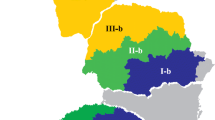Abstract
Tan spot, caused by Pyrenophora tritici-repentis, is a common disease in wheat-growing regions of Argentina. In this study 65 isolates of P. tritici-repentis obtained from different cultivars and wheat regions of Argentina were assessed for their virulence on six wheat cultivars/lines (Glenlea, Salomouni, Katepwa, M-3, 6B365 and 6B662) and for the presence/absence of the Tox genes based on a PCR approach. Thirty-six isolates were assigned to races, of which races 4 and 8 were dominant. Results for molecular analysis of ToxA, ToxB, ToxB-like and toxb genes showed that 57 isolates possessed the ToxA gene whereas only one isolate possessed ToxA and ToxB genes. There was no correlation between races and the toxin genotypes. It is suggested that P. tritici-repentis exhibits a complex race structure in Argentina.
Similar content being viewed by others
References
Ali S, Francl LJ (2002) Race structure of Pyrenophora tritici-repentis isolates obtained from wheat in South America. Plant Prot Sci 38:302–304
Ali S, Francl LJ (2003) Population race structure of Pyrenophora tritici-repentis prevalent of wheat and non-cereal grasses in the Great Plains. Plant Dis 87:418–422
Ali S, Ling H, Meinhardt S, Francl LJ (2002) A new race of Pyrenophora tritici-repentis that produces a putative host–selective toxin. Phytopathology 92:S3
Ali S, Gurung S, Adhikari TB (2010) Identification and characterization of novel isolates of Pyrenophora tritici-repentis from Arkansas. Plant Dis 94:229–235
Andrie RM, Pandelova I, Ciuffetti LM (2007) A combination of phenotipic and genotypic characterization Pyrenophora tritici-repentis race identification. Phytopathology 97:694–701
Araya CM (2003) Coevolución de interacciones hospedante-patógeno en frijol común. Fitopatol Bras 28:221–228
Ballance GM, Lamari L, Kowatsch R, Bernier CC (1996) Cloning, expression and occurrence of the gene encoding the Ptr necrosis toxin from Pyrenophora tritici-repentis. Mol Plant Pathol. www.bspp.org.uk/mppol/1996/1209ballance/. Accessed 22 May 2002
Ciuffetti LM, Tuori RP, Gaventa JM (1997) A single gene encodes a selective toxin causal to the development of tan spot of wheat. Plant Cell 9:135–144
Ciuffetti LM, Francl LJ, Ballance GM, Bockus W, Lamari L, Meinhardt SW, Rasmussen JB (1998) Standarization of toxin nomenclature in the Pyrenophora tritici-repentis/wheat interaction. Can J Plant Pathol 20:421–424
Effertz RJ, Meinhardt SW, Anderson JA, Jordahl JG, Francl LJ (2002) Identification of chlorosis-inducing toxin from Pyrenophora tritici-repentis and the chromosomal location of an insensitivity locus in wheat. Phytopathology 92:527–533
Ellis MB (1976) More dematiaceous hyphomycetes. Commonwealth Mycological Institute, Kew
Fernandez MR, Clarke JM, DePauw RM (1994) Response of durum wheat kernels and leaves at different growth stages to Pyrenophora tritici-repentis. Plant Dis 78:597–600
Gamba FM, Strelkov SE, Lamari L (2012) Virulence of Pyrenophora tritici-repentis in the Southern Cone Region of South America. Can J Plant Pathol. doi:10.1080/07060661.2012.695750
Kohli MM (1995) Conceptos básicos en el manejo de enfermedades de cultivos. In: Kohli MM, Annone JG, García R (eds) Curso de manejo de enfermedades del Trigo. INTA-CIMMYT, Buenos Aires, pp 23–29
Lamari L, Bernier CC (1989a) Evaluation of wheat lines and cultivars to tan spot (Pyrenophora tritici-repentis) based on type lesions. Can J Plant Pathol 11:49–56
Lamari L, Bernier CC (1989b) Virulence of isolates of Pyrenophora tritici-repentis on 11 wheat cultivars and cytology of the differential host reactions. Can J Plant Pathol 11:284–290
Lamari L, Sayoud R, Boulif M, Bernier CC (1995) Identification a new race in Pyrenophora tritici-repentis: implications for the current pathotype classification system. Can J Plant Pathol 17:312–318
Lamari L, Strelkov SE, Yahyaoui A, Orabi J, Smith RB (2003) The identification of two new races of Pyrenophora tritici-repentis from the host center of diversity confirms a one-to-one relationship in tan spot of wheat. Phytopathology 93:391–396
Manning VA, Pandelova LM, Ciuffetti LM (2002) A race for a novel host-selective toxin. Phytopathology 92:S51
Manning VA, Andrie R, Trippe A, Ciuffetti LM (2004) Ptr ToxA requires multiple motifs for complete activity. Mol Plant-Microbe Interact 17:491–501
Moreno MV, Perelló, AE (2010) Occurrence of Pyrenophora tritici-repentis causing tan spot in Argentina. In: Arya A, Perelló A (eds) Management of fungal pathogens: current trends and progress. CABI Publishers, Wallingford, UK, pp 275–290
Moreno MV, Stenglein SA, Perelló AE, Balatti P (2008) Pathogenic and genetic diversity of isolates of Pyrenophora tritici-repentis causing tan spot of wheat in Argentina. Eur J Plant Pathol 122:239–252
Moreno MV, Stenglein SA, Perelló, AE (2012) Pyrenophora tritici repentis, the causal agent of tan spot: a review of intraspecific genetic diversity. In: Caliskan M (ed.) Genetic Diversity / Book 2. INTECH Publisher, Rijeka, Croatia, pp 297–330
Orolaza NP, Lamari L, Balance GM (1995) Evidence of a host-specific chlorosis toxin from Pyrenophora tritici-repentis, causal agent of tan spot of wheat. Mol Plant-Microbe Interact 3:221–224
Simón MR, Ayala FM, Golik SI, Terrile II, Cordo CA, Perelló AE, Moreno MV, Chidichimo H (2011) Integrated foliar disease management to prevent yield loss in Argentinian wheat production. Agron J 103:1441–1451
Stenglein SA, Balatti PA (2006) Genetic diversity of Phaeoisariopsis griseola in Argentina as revealed by virulence and molecular markers. Physiol Mol Plant Pathol 68:158–167
Strelkov SE, Lamari L (2003) Host-parasite interaction in tan spot Pyrenophora tritici-repentis of wheat. Can J Plant Pathol 25:339–349
Strelkov SE, Lamari L, Sayoud R, Smith RB (2002) Comparative virulence of chlorosis-inducing races of Pyrenophora tritici-repentis. Can J Plant Pathol 24:29–35
Acknowledgments
This work was supported by grants provided by the Universidad Nacional de La Plata, Proyecto Regional Trigo-PROCISUR, and PIP 0295 CONICET. We thank, Dr. S Ali, Dept Plant Pathology, North Dakota State University, USA, for providing seeds of wheat and Lic. M. Oyarzabal for English assistance.
Author information
Authors and Affiliations
Corresponding author
Additional information
Section Editor: Nilceu Nazareno
Rights and permissions
About this article
Cite this article
Moreno, M.V., Stenglein, S. & Perelló, A.E. Distribution of races and Tox genes in Pyrenophora tritici-repentis isolates from wheat in Argentina. Trop. plant pathol. 40, 141–146 (2015). https://doi.org/10.1007/s40858-015-0011-2
Received:
Accepted:
Published:
Issue Date:
DOI: https://doi.org/10.1007/s40858-015-0011-2




